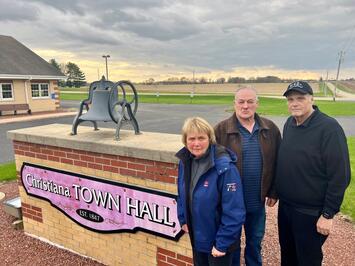
When I arrived at the Christiana Town Hall yesterday afternoon, Mark A. Cook, the town chairman, and two local landowners, John Barnes, and Roxann Engelstad, were ready and waiting. They had multiple maps and charts showing the footprint and details of Invenergy’s proposed 300-megawatt Koshkonong Solar Energy Center.
Cook got right to the point. Christiana, he said, has been “based on agriculture since people settled here. This project will completely kill ag in this town for generations.” The solar project is targeting “our very best farmland. It’s not like they are taking the crap land. This is the cream of the crop.” He went on, saying that the company is targeting farmland because it’s relatively flat and therefore will be easy to cover with panels. In addition, Christiana is near a gas-fired power plant that is connected to the high-voltage transmission grid. That location will make it easy for the proposed solar project to get its electricity onto the grid.
About 1,800 people live in Christiana, which is located 70 miles west of Milwaukee. It sits amid picturesque rolling hills and farms that mostly grow corn and soybeans. The landscape is marked with thickly wooded patches of trees and shrubs that have grown back in the areas that aren’t under the plow. The soil is a rich, dark brown. Under cloudy skies, the tilled land looks almost black.
Cook, who is also the president of the Cambridge Area Fire and EMS Commission, told me Christiana operates on a budget of about $3.8 million. It has already spent about $200,000 in legal fees fighting the Invenergy project. It has filed one lawsuit to stop the $650 million project and will soon file another suit against the Wisconsin Public Service Commission. The town is claiming the agency violated the Wisconsin Constitution and the commission’s own rules when it granted a permit for the project last year. More about the legal details in a moment.
The fight in Christiana provides yet another snapshot of the land-use conflicts over renewables that are raging all across the country. People like Cook, Barnes, Engelstad, and the other people in Christiana, are not NIMBYs, the slur that project developers and many climate activists like to use when describing people who are fighting big renewable projects.
Instead, their efforts to protect Christiana and its farmland from the energy sprawl that comes with large-scale renewable projects are directly in line with the views of an overwhelming majority of Americans. In March, a new media outlet called Heatmap (“focused on the biggest story in the world: the great climate and energy transition”) published the results of a poll of 1,000 adult Americans.
The poll, which included people from all 50 states, found that “79% of Americans said that new renewable energy should be rolled out ‘slowly’ rather than ‘quickly’ and that the conservation of land and wild animals should be prioritized above rapid greenhouse-gas reductions.”
Read the rest of this piece at Robert Bryce Substack.
Robert Bryce is a Texas-based author, journalist, film producer, and podcaster. His articles have appeared in a myriad of publications including the Wall Street Journal, New York Times, Forbes, Time, Austin Chronicle, and Sydney Morning Herald.
Photo: Roxann Engelstad, John Barnes, and Town Chairman Mark A. Cook, at the Christiana Town Hall, April 25, 2023. Photo courtesy Robert Bryce Substack.












